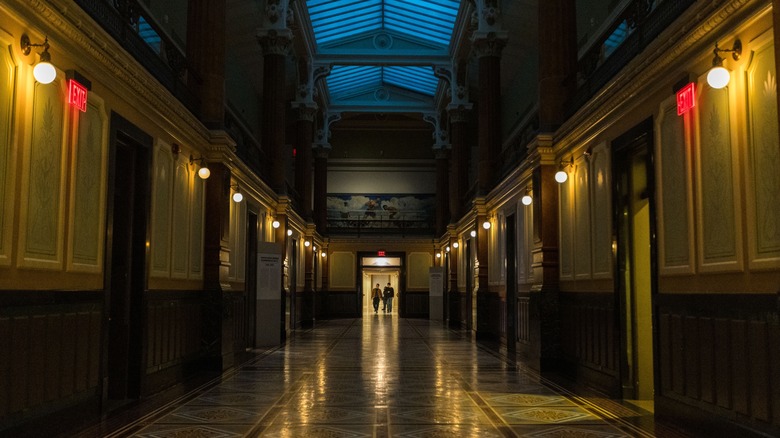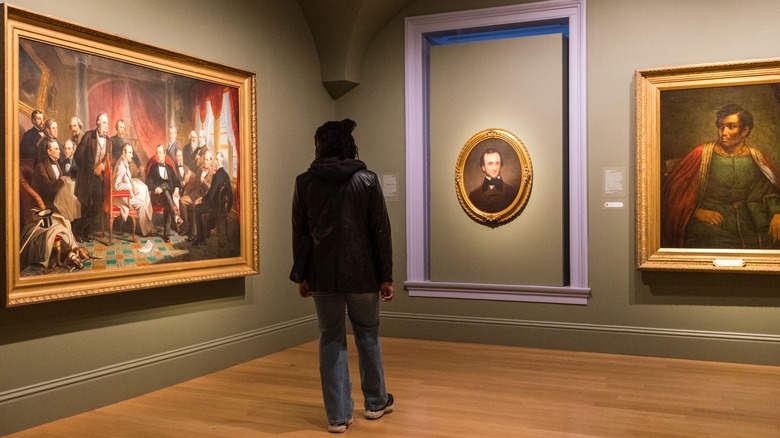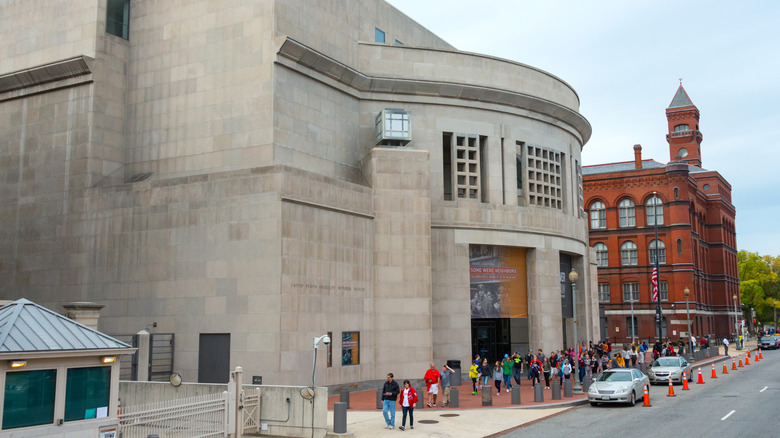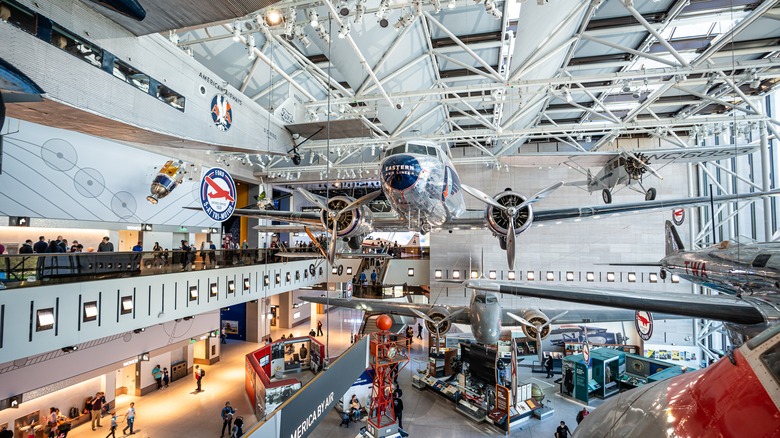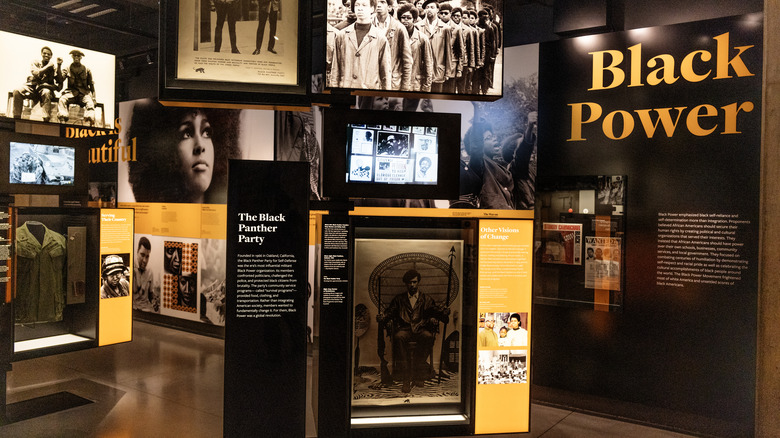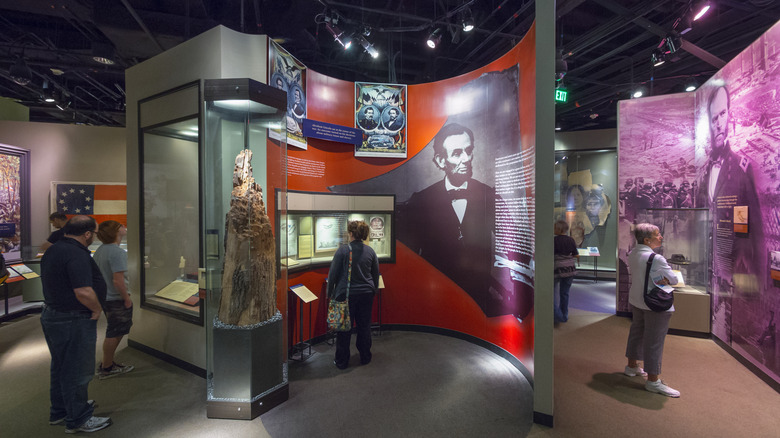The 'Capital Of Free Museums' Is America's Most Affordable And Iconic Destination For History Buffs
If you're an American history buff, there are plenty of cities around the nation that can make you feel like you're stepping back in time. If you're looking for a true deep dive, though, your best bet is probably Washington D.C. In between walking tours and visits to historical sites, you can visit many free museums and leave with a greater understanding of the systems and events that shaped our world. Between the cost of transportation, hotels, and food, Washington D.C. can be an expensive city to visit. Fortunately, however, many of the best activities to do on vacation in D.C. are actually free — including its world-class museums.
Washington D.C.'s official website dubs the city "The Capital of Free Museums," and it lives up to the name with plenty of them available to visit for free. From the high-tech, voice-activated displays of Planet Word to the Smithsonian's National Postal Museum and its deep dive into the history of mail, there are exhibits to entertain visitors of all kinds.
If you love history, however, there are a few you can't miss. Look into the eyes of some of the most prominent figures in history at the National Portrait Gallery, pay your respects at the United States Holocaust Memorial Museum, dive into the history of flight at the National Air and Space Museum, experience the history of America through the lens of Black Americans at the Smithsonian's National Museum of African American History, and explore the National Museum of American History to see everything from awe-inspiring exhibits about Civil Rights to props from some of the most iconic films in Hollywood history. These fascinating museums are all completely free, and the knowledge you take home with you will last a lifetime.
See portraits of America's most influential figures at The National Portrait Gallery
Art and history have always been deeply tied together, but the collection at The National Portrait Gallery was specifically founded with the goal of collecting images of the people who shaped the United States. It's one thing to read about someone's life, it's another to look into their eyes and imagine what their life was actually like. One of the most famous exhibits in the museum is called "America's Presidents" and features a portrait of each president of the United States — including the famous "Lansdowne" George Washington, painted by Gilbert Stuart; the most famous photograph of Lincoln, taken by Alexander Gardner; and the striking portrait of Barack Obama set against a backdrop of verdant greenery, painted by Kehinde Wiley.
Not only is the museum's collection free to visit, but it also hosts plenty of free events like curator tours, sketching sessions in the galleries for adults, and crafts, story times, and talks for families, so make sure to check the events calendar and register for anything you'd like to try during your visit.
Unfortunately, though, there isn't a lot of parking in the area — and it certainly isn't free. Thankfully, The National Portrait Gallery is less than a 15-minute walk from the National Mall, so it's easy to fit in a visit with the rest of your sightseeing. Plus, you can always take advantage of Washington D.C.'s excellent public transit system and hop off the metro at the Gallery Place/Chinatown station. Admission-wise, the museum is open every day from 11:30 a.m. to 7 p.m.
Confront the past at the United States Holocaust Memorial Museum
This unique and powerful museum transports visitors to one of the most devastating events in human history. In some museums, you might pick and choose which wings to explore, but at the Holocaust Memorial Museum's central collection, there's only one way through. As you walk, you'll be taken on a harrowing journey through time — beginning with the Nazi rise to power, memorializing the 6 million Jews and millions of others murdered in the name of fascism and antisemitism, and the liberation of the Nazi death camps. Along the way, visitors will see items collected from the ghettos and camps, as well as hear the first-hand testimony of Holocaust survivors, recorded as a warning to future generations.
If you are visiting with young family members, consider "Remember the Children: Daniel's Story," a short interactive experience intended for children ages 8 and up that tells the story of a Jewish child in Nazi Germany. Although the story itself is fictional and designed to help children understand this time in history, it is told using real historical photographs and diary entries in an interactive setting that lets you step into Daniel's world.
To see the museum's main exhibit, you will need to secure a timed entry ticket online in advance. These are free, but be prepared to pay a $1 transaction fee for the booking. Other exhibits, like "Daniel's Story," don't require tickets. The Holocaust Museum is open from 10 a.m. to 5:20 p.m. every day, except for a few select holidays. It is located right on the National Mall, so the only available parking is in paid garages. If you would rather take the Metro, hop off at the Smithsonian station.
Learn the history of flight at the National Air and Space Museum
Science and history meet at one of Washington D.C.'s most remarkable museums, where you can see everything from historic planes to spacecraft. Walking into the Smithsonian National Air and Space Museum feels like entering the most exciting airplane hangar imaginable. On the floor and suspended from the rafters high above, you can see all kinds of devices humankind has used to fly.
You could spend the whole day here, but if you're short on time, keep an eye out for the information about race pilot Neal Loving and his brilliant red racing plane near the entrance. From there, find the Wright Flyer — the first plane to complete a successful flight — in "The Wright Brothers & the Invention of the Aerial Age" exhibit. Finally, finish your visit with a trip to the exciting "Destination Moon" to see objects from the moon missions, including Neil Armstrong's actual space suit from Apollo 11. If you're a science fiction fan, make sure to look for the model of the iconic Enterprise, used in the original "Star Trek" series.
It's free to visit the National Air and Space Museum, but you will need to reserve a timed entry ticket to get in. The museum is open daily between 10 a.m. and 5:30 p.m., so you'll have plenty of opportunities. However, if you do miss your chance to get a ticket in advance, try checking the website at 8:30 a.m. to snag one of the few limited same-day passes. While you will be prompted to donate while checking out, it's not required to visit the museum. You can find this museum in the middle of everything on the National Mall, but if you want to take the metro, get off at L'Enfant Plaza.
Explore the National Museum of African American History and Culture
The story told by the National Museum of African American History and Culture is the story of America. The museum's brutal exhibits on the history of trafficking in the U.S. on the lowest floor pull no punches, and the devastating stories of Africans forced into enslavement will certainly stick with you — particularly the records of those who did not survive the journey across the ocean. The horrors the survivors faced are little better, but visitors are sure to be awed by the tales of resistance and rebellion.
The museum is also packed with examples of Black excellence. As you continue your journey upwards, you'll learn about the heroes of the Civil Rights movement and the stories of trailblazing Black Americans, from athletes and fashion designers to activists. Seek out a rare, casual photograph of larger than life American hero Harriet Tubman, showing a rare glimpse of the woman behind the legend. You can also find the dress Rosa Parks was sewing during her famous act of passive resistance when she refused to give up her seat on the bus. Don't miss the top floor of the museum, which dives into the history of music in America and highlights the contributions of some of the greatest musicians of all time, and keep an eye out for Prince's purple heels in the Musical Crossroads Gallery.
While the museum is free, you will have to reserve timed entry passes in advance through the museum website. Open from 10 a.m. every day except Monday, when it opens at noon, final entry is at 4 p.m. — though visitors already inside can explore until 5:30 p.m. The museum is also on the National Mall, and the closest metro station is Federal Triangle.
Discover American culture at the National Museum of American History
If you're traveling to the U.S. capital to learn everything you can about the history of the country, you won't want to miss the National Museum of American History. It covers an incredibly broad scope of American politics, activism, science, technology, and pop culture throughout the nation's history. You can see the battle-torn flag that inspired Francis Scott Key to write the "Star Spangled Banner," the iconic top hat worn by Abraham Lincoln on the day of his assassination, and visit the actual Woolworth lunch counter that once refused to serve anyone who wasn't white — and where four young Black protesters peacefully refused to give up their seats, sparking a powerful youth movement for equality.
You can also visit "The Entertainment Nation" exhibit to see items that have shaped American culture. Keep your eyes out the sparkling ruby slippers worn by Judy Garland in "The Wizard of Oz," R2-D2 and C-3PO from "Star Wars," one of Mr. Rogers' sweaters, and many of the original Muppet puppets, including Bert, Ernie, and Fozzie Bear.
The museum is open every day except for Christmas Day. Conveniently, for those trying to squeeze a few places into one day, it's also right on the National Mall — just be prepared that, on busy days, you may have to wait to get in. There are very few parking spots nearby, and all are paid, so you're definitely better off taking the Metro to Federal Triangle station. It's totally free to visit and you don't even need to reserve a pass in advance. If you're worried about crowds, try to get there right at opening (10 a.m.) before the larger tour groups arrive, or between 3 p.m. and closing at 5:30 p.m., when there won't be class trips.
